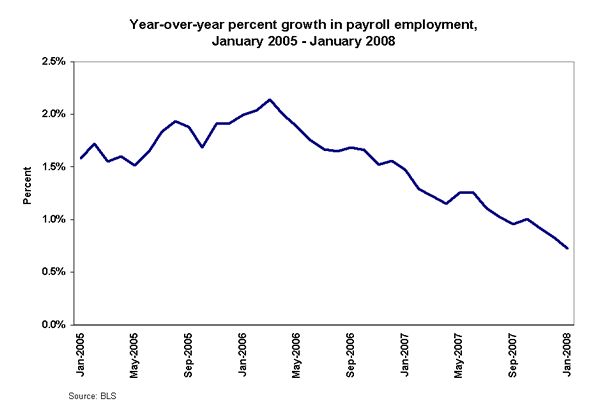February 1, 2008
Recessionary conditions appear in the job market
by Jared Bernstein with research assistance from James Lin
The number of jobs in the nation fell last month for the first time in almost five years, the clearest signal yet that the labor market is in a recession or teetering on the brink of one. Payrolls were down 17,000, led by losses in construction, manufacturing, and state government. In another recessionary sign, hours worked declined both on a weekly basis and in aggregate across the private sector.
Averaging over the past three months, the BLS’s Establishment Survey showed that payrolls grew by a scant 42,000 jobs per month, compared to 169,000 a month over the comparable period one year ago.
Excepting health care, most industries across the economy either shed jobs or grew considerably more slowly than in recent months. Housing market pressures were evident in both construction hiring and unemployment. Jobs in residential construction and contracting were down 28,000 over the month and 244,000 over the past year. Unemployment in the industry was in double-digits at 11%.
Despite modest dollar-related gains in exports, factory job losses were large and wide-spread last month with almost every sub-sector in both durable and non-durable goods shedding a total of 28,000 jobs.
The service sector, including government, posted only 34,000 net new jobs in January, after averaging 132,000 per month over the past year.
The Household Survey had a few brighter spots, as the unemployment rate ticked down to 4.9%, and the share of the population employed, which had been falling, rose two-tenths of a percent. (In actuality, the change in the unemployment rate was slight, dropping from 4.98% in December to 4.93% last month). However, this survey also flashed some recessionary signals. Long-term unemployment—the share of workers jobless for at least half-a-year—jumped to18.3%, compared to 16.2% one year ago. In fact, the number of long-term unemployed is higher today (1.38 million) than it was in March 2002 (1.33 million), when Congress first enacted extended unemployment compensation after the 2001 recession.
Another important indicator of slack in the job market was the increase in the share of involuntary part-time workers, a change that is also evident in the increase in the under-employment rate, the BLS’s most comprehensive measure of under-utilization. At 9.0% last month, the underemployment rate was at its highest level in over two years and significantly above its year-ago level of 8.3%.
As noted, average weekly hours fell one-tenth of an hour. Combined with the loss of jobs, this led to a 0.3 decline in the index of total hours worked over the month. Over the past year, the index of total hours worked is up only 0.9%, the smallest growth in almost four years.
Today’s report also includes a series of annual revisions that reduced the level of jobs as of December last year by 376,000 (seasonally adjusted). This downward revision makes the already historically weak jobs record over this business cycle even weaker. Assume, for purposes of comparison, that payroll employment peaked in December 2007.. Before the revision, the growth rate over the entire cycle, from March 2001 to December 2007, was only 4.5%, compared to job growth of about 20% in each of the last two business cycles. Post revision, the increase drops to 4.2%. In other words, job creation was exceptionally weak thus far in the 2001 business cycle, a cycle which may well have already peaked.
Given the monthly revisions in the payroll data, one always needs to be cautious about extrapolating from a single monthly job report. However, today’s decline in payrolls is wholly consistent with the clear pattern of slowing job growth. The chart below shows annual percent changes in the newly revised payroll data over the past three years, portraying an unmistakable slowdown in job growth. The fact that we “crossed zero”—that is, actually lost jobs on net last month—is consistent with a job market that has been weakening for some time.
Given the critical importance of the labor market to the economic well-being of American families, policy makers must continue to address the developing recessionary conditions. The economy grew at only 0.6% in the last quarter, demonstrably too slow to promote robust job growth. Long-term unemployment appears to be on the rise, and most industries are retrenching. The highly leveraged American consumer is already feeling the effects of slowing wage growth and faster inflation. Efforts to stimulate growth through monetary and fiscal policy are now even more urgently needed.

To view archived editions of JOBS PICTURE, click here.
The Economic Policy Institute JOBS PICTURE is published each month upon release of the Bureau of Labor Statistics’ employment report.
EPI offers same-day analysis of income, price, employment, and other economic data released by U.S. government agencies. For more information, contact EPI at 202-775-8810.